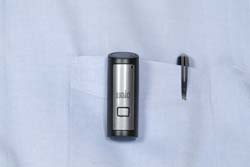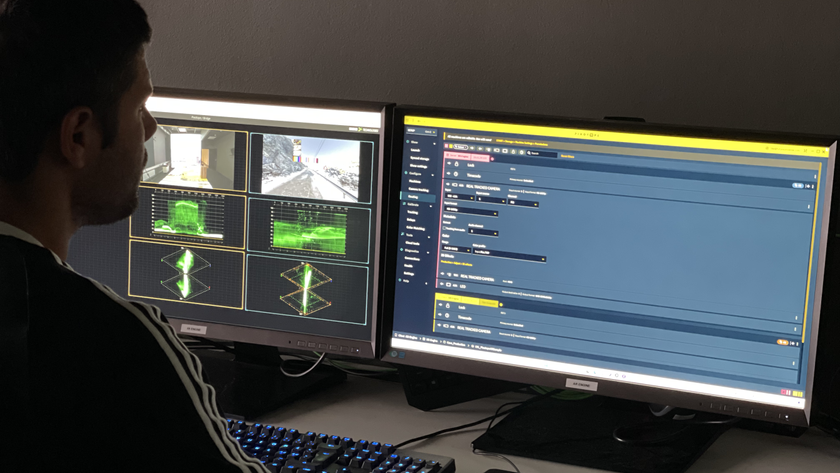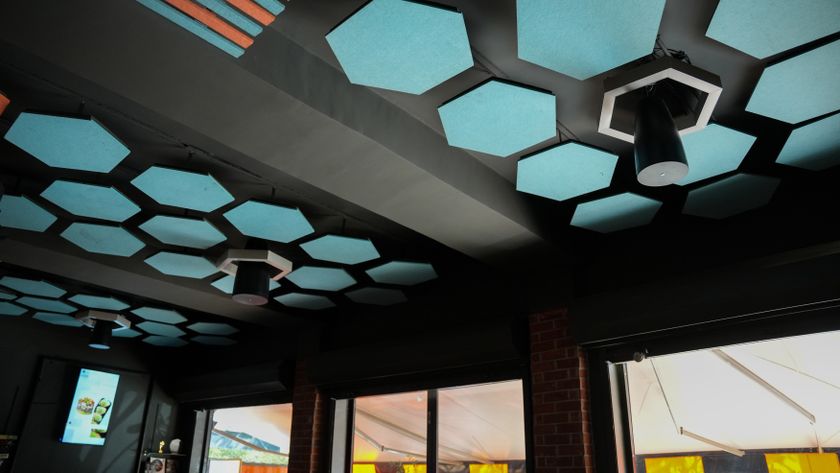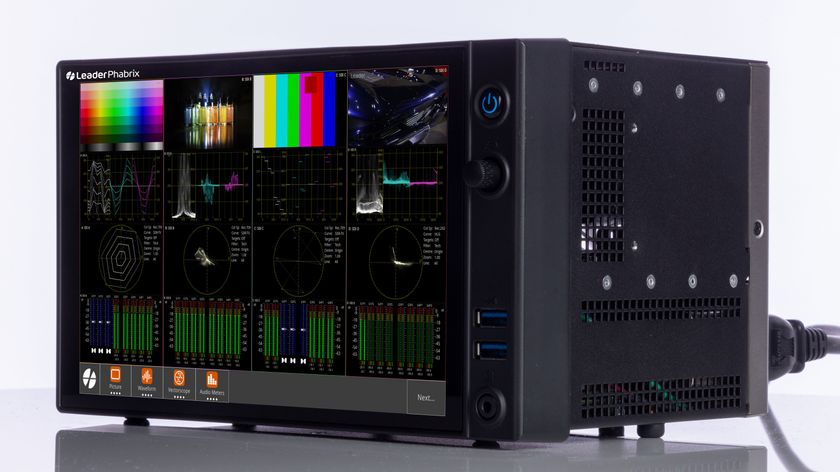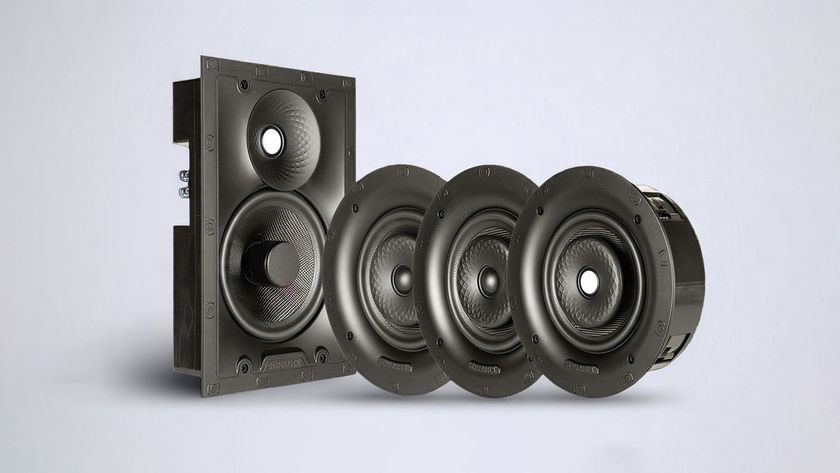- Videoconferencing, perpetually the "next big thing", seems finally to have become somewhat quantifiable. Whether intended for new construction or a retrofit, a small conference room or a far-flung corporate network, a rural elementary school, or a prestigious university's medical program, some expectations have been set. Videoconferencing products are available at a variety of price points. The popularity of IP-based topologies has established the necessity of dedicated networks. And latency is a thing of the past in most cases.
Wireless mics, such as this wearable mic from Revolabs' Solo wireless conference microphone system, offer a range of flexibility that makes them appealing in all videoconferencing applications.
In short, the video part of videoconferencing is there. The CEO no longer looks like an actor in a poorly dubbed foreign film. Even the talking-head scenario has been replaced in high-end applications by high-definition virtual meeting rooms. Unfortunately, what sparks the most complaints during videoconferences is invisible. This frustrating enemy of a successful meeting is known simply as "bad audio," but it also answers to "I can't hear you" and "what are they saying?"
There is an old adage that states that if the video goes out during a videoconference, the meeting can continue, but if the audio goes out, the meeting is cancelled. Tragically, the audio doesn't always disappear completely from a meeting, often it merely becomes indecipherable, which means that everybody tries to stay on the line. Hence, the formerly ubiquitous table mics have been joined by ceiling mics, gooseneck mics, lavalier mics, and even handheld mics in the battle against meeting failure due to poor intelligibility. Despite the progress offered by integrating commercial microphone systems with videoconferencing equipment, this trend also introduces new variables in audio quality, specifically mic placement and room acoustics.
Recently, there has been more attention paid to these areas in response to vast numbers of meeting participants objecting to poor audio quality. "One of the biggest steps forward in videoconferencing is the sound," said Mark Basford ReView Video's director of product management. "Typically, 80 percent of what we take in is sound. The good pictures are great, but the thing that really wears on you if you're in any kind of long conference is the sound quality. If you're listening to poor sound quality, it's much more tiring than looking at a poor picture."
The first step in achieving high-quality audio to accompany high-quality video is the room itself. It is still a somewhat rare occasion when a room is purpose-built for videoconferencing, which means that much has to be taken into account when attempting to make an existing room sound better.
Noise level and excessive reverberance are common problems in existing boardrooms. Of these two trouble spots, high ambient noise is likely to be a more troublesome circumstance, especially since any extraneous noise that is created in one meeting room is sent to the remote room and then sent back, creating audio havoc. The only solution there is a "better environment," said Tom Schulte, an application engineer with Sencore, "and better construction methods for anticipated videoconferencing rooms so that you have less noise entering from adjacent rooms and mechanical systems like HVAC."
Where that is not possible, "you may have to retrofit some of the isolation, or correct some of the noise sources," Schulte elaborated. "As an example, with HVAC you can put in low-noise diffusers or mufflers. Or a retrofit may involve something as simple as putting in a heavier entry door, or one with a threshold sweep to seal the bottom of the doorway to keep out hallway noise and outside conversations."
Since even these modifications are sometimes not in the budget, a common reparation for poor audio quality is to move beyond the tabletop mic to a close mic'ing scenario for a better signal to noise ratio. "That way, the mic will pick up more of the desired sound," Schulte said. "Lavaliers are being used in more cases, and that's of course the better situation."
As one of the leading causes of poor audio quality in a videoconference, HVAC noise is the target of many new microphone solutions. "In the past 10 years there have been advancements in microphones such as boundary layer microphones, miniature gooseneck microphones and in specific ceiling mics that have been designed to help reduce HVAC noise," noted Bob Lowig business unit manager of conference and presentation products for beyerdynamic. "Little short gooseneck microphones have been designed to be mounted into the ceiling, and the polar patterns of the microphones are rear canceling, so they reduce the sound of the HVAC or fan noise from a camera."
Multi-Tasking In The Boardroom
Another evolutionary step in microphones for videoconferencing applications has been the introduction of wireless conferencing stations that offer protocol control and options that include request to speak, on and off, push to talk or automatic voice operation to help a meeting progress more smoothly. Their portability is another plus. "Years ago, or even recently, hardwired microphones were plugged into a third party device which would gate the microphones," Lowig said. "You could go in there and limit the number of open microphones if you wish, but it was all done hardwired. To be able to accomplish this in a wireless format is a milestone in terms of conferencing systems for the industry."
Wireless mics offer another benefit that makes them appealing in all applications, and that is flexibility. "Integrators are finding that a lot more of boardrooms are designed to be more flexible," said JP Carney, chief operating officer of Revolabs. "One day it's laid out one way, one day it's a horseshoe, and they do different types of meetings in the rooms, sometimes training, sometimes conference calls. And suddenly integrators are finding that they're getting complaints, and it's not because they didn't do the job they were supposed to, it's because the audio isn't flexible enough. When you have to wire it in, you're stuck. So having the wireless system is really nice for a lot of applications because it allows them to have different types of microphones in the same room."
Along with the good comes the bad, since wireless mics also introduce security concerns. "Some people don't even realize that these wireless solutions aren't safe unless they're encrypted. All it takes is a $45 receiver and someone can listen to you five miles away. Whether you're talking about raises or a merger and acquisition, that's sensitive information and there's a lot of that stuff that goes on day to day."
Another type of shield was also developing in response to the needs of the conferencing market. "Radio frequency interference shielding in boardroom microphones has become a very serious issue in the past three or four years," Lowig observed. "There were concerns about Blackberries and cell phones are radiating a digital handshake that is picked up by microphones and reproduced in the audio system. It became such a problem here in the U.S. that most of the major manufacturers now produce their lines of conferencing microphones with RFI shielding on them to prevent this from happening. It's almost a requirement now if you want to sell microphones into that market."
Networking Goes Beyond The Handshake
There will soon be another option in wired conference mic setups-audio over Cat-5. Aviom will introduce its AV-M8 eight-channel mic input module for standalone conferencing at NSCA Expo this month. It is currently testing its integration with videoconferencing codecs. "We are working with a lot of different companies to make sure that our protocol is going to be integratable with a lot of different solutions," said Jason Frenchman, director of marketing for Aviom. "When you send your audio over Cat-5 there is a lot less wiring involved, which means the job gets done faster."
Cat-5 cable has certainly found a home in videoconferencing applications already, as ISDN has mostly given way to IP solutions. This is one area where audio and video have equal potential to be put in harm's way. "When both audio and video are over IP, unless you're on your own private network, you're at the mercy of the switchers and the hubs across the country," Basford said. "In the convergence of AV and IT, videoconferencing is really where the two meet."
Much has been done in terms of product development to improve the quality of audio in videoconferencing applications. Consultants and integrators who work in this space are well versed in the hardware options that will make their clients happy. But acoustical considerations, the invisible attributes of a good-sounding system, remain a difficult sell, especially in applications with smaller budgets. Still, with the increasing number of videoconferencing customers who are noticing the audible detriments of their system, perhaps there is hope.
"Most of the major integrators that we deal with on a regular basis employ acoustical specialists now," Basford said. "They can make a really good case with data on paper. Beyond that, being able to demonstrate what a good call sounds like is key. It really comes down to the person who's going to use it."
Aviom...www.aviom.com
beyerdynamic...www.beyerdynamic.com
ReView Video... www.reviewvideo.com
Revolabs...www.revolabs.com
Sencore...www.sencore.com
Measure For Measure
Whether or not an integrator is experienced with boardroom audio for videoconferencing, the industry education available at trade shows or SynAudCon can provide a primer on measuring room acoustics and intelligibility. These courses will provide an understanding of how to use the different functional tests available in measuring equipment, which tests should be used, and how to interpret the results.
Meanwhile, Tom Schulte, application engineer with Sencore, had some advice to get you started. For videoconferencing rooms, he recommended a multiband RT-60 test to determine whether the low frequency RT-60 is excessive compared to the higher-frequency RT-60. "In the low-frequency bands you don't want the RT-60 to be more than about three times what it is in the high frequency bands. A broadband measurement, where it just lumps everything from 20Hz to 20kHz may not show you the fact that your low frequencies are fairly reverberant. Whereas is you measure band by band, you'll see that the low-frequencies are significantly high." If that is the case, low-frequency absorption will usually improve the situation.
In terms of when measurements should be made, Schulte said that with existing rooms, tests should be done sooner rather than later, as it may become apparent that steps need to be taken to improve the acoustics before the electronics are installed.
Measuring a room after the installation is complete might provide an indicator of how successful the system is. "During the final commissioning test, the speech intelligibility test might show low," Schulte said. "In speech intelligibility there are three factors, background noise, reverberation time of the room, and also the quality of the system itself. So if the reverberation is what seems to be acceptable, and the background noise isn't excessive, and yet speech intelligibility tests poorly, you might have microphone or electronics issues. Distortion in the system will give you poor speech intelligibility."
Today there are electronic intelligibility tests that provide fair representations of actual room conditions. For example, the STIPA (Speech Transmission Index for PA) test can be done fairly quickly in the field, and it has a fairly high correlation to actual performance.
Sencore's new SP395 Audio Integrator and SP495 Audio Consultant professional grade audio analyzers perform somewhere around 30 different functional tests. These include some that would be of interest in videoconferencing rooms: background noise, noise criteria, reverberation, and speech intelligibility tests. Additionally, for sound quality, frequency response is a concern, and the new analyzers provide RTA and FFT analyzers that would help in that regard.
